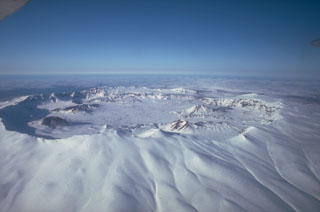Report on Okmok (United States) — 16 July-22 July 2008
Smithsonian Institution / US Geological Survey
Weekly Volcanic Activity Report, 16 July-22 July 2008
Managing Editor: Sally Sennert.
Please cite this report as:
Global Volcanism Program, 2008. Report on Okmok (United States) (Sennert, S, ed.). Weekly Volcanic Activity Report, 16 July-22 July 2008. Smithsonian Institution and US Geological Survey.
Okmok
United States
53.43°N, 168.13°W; summit elev. 1073 m
All times are local (unless otherwise noted)
AVO reported that during 15-16 July seismicity from Okmok changed from nearly continuous to episodic volcanic tremor, and the overall seismic intensity declined. Satellite imagery indicated elevated surface temperatures in the NE sector of the caldera; meteorological clouds obscured views. On 16 July, the Volcano Alert Level was lowered to Watch and the Aviation Color Code was lowered to Orange. On 17 July, a pilot reported that an ash plume rose to altitudes of 4.6-6.1 km (15,000-20,000) a.s.l. and drifted E and NE. On 18 July, AVO indicated that the eruption was episodic, with occasional ash-producing explosions occurring every 15 to 30 minutes. The plumes from these explosions were limited to about 6.1 km (20,000 ft) a.s.l.
On 19 July seismicity increased markedly, interpreted as possibly indicating that ash plumes rose to altitudes of 7.6-9.1 km (25,000-30,000 ft) a.s.l. The Volcano Alert Level was raised to Warning and the Aviation Color Code was raised to Red. The next day, seismicity declined again and the Volcano Alert Level was lowered to Watch and the Aviation Color Code was lowered to Orange. Satellite imagery revealed that an ash plume about 20 km from Okmok drifted SE at an altitude of 3.7 km (12,000 ft) a.s.l. Additional ash plumes observed on satellite imagery and spotted by pilots rose to altitudes of 4.6-6.1 km (15,000-20,000 ft) a.s.l. During 21-22 July, ash plumes rose to altitudes of 6.1-9.1 km (20,000-30,000 ft) a.s.l. and drifted SE.
Geological Summary. The basaltic Okmok shield volcano forms the NE end of Umnak Island in the Aleutian Islands. The summit of the low, 35-km-wide volcano is cut by two overlapping 10-km-wide calderas formed during eruptions about 12,000 and 2,050 years ago when dacitic pyroclastic flows reached the coast. More than 60 tephra layers from Okmok have been found overlying the 12,000-year-old caldera-forming tephra layer. Numerous cones and lava domes are present on the flanks down to the coast, including the SE-flank Mount Tulik, which is almost 200 m higher than the caldera rim. Some of the post-caldera cones show evidence of wave-cut lake terraces; more recent cones were formed after the caldera lake, once 150 m deep, disappeared. Eruptions have been reported since 1805 from cinder cones within the caldera, where there are also hot springs and fumaroles.
Source: US Geological Survey Alaska Volcano Observatory (AVO)

